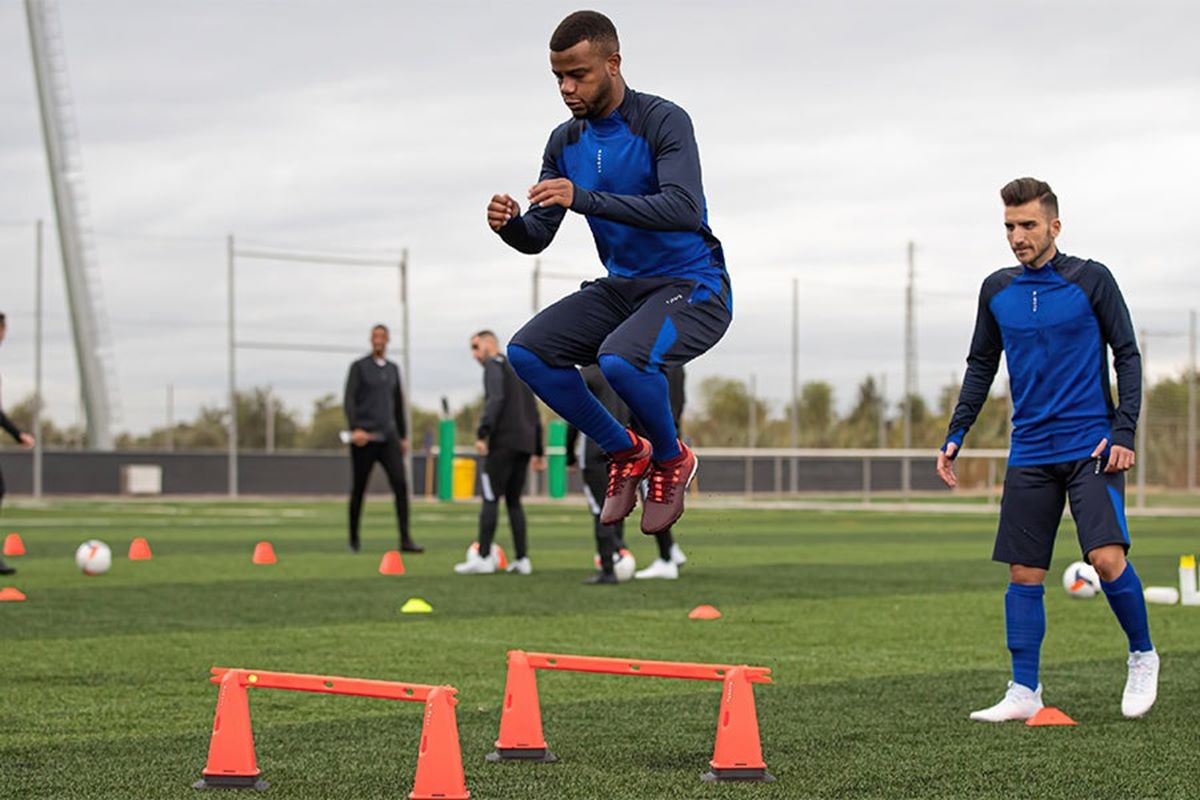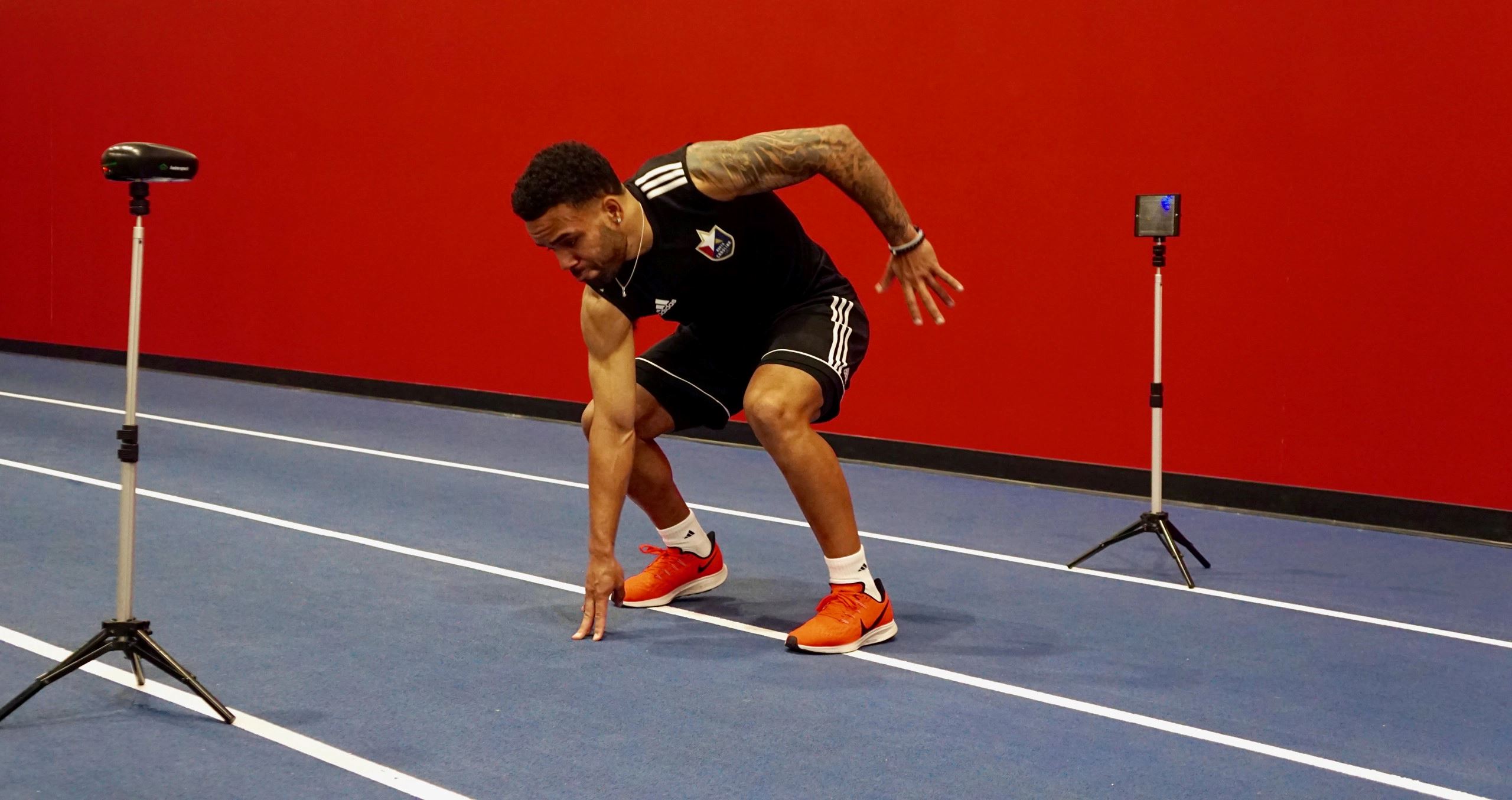

Featured
How To Improve Stamina In Soccer
Published: October 15, 2023
Learn the best strategies and exercises to improve stamina in soccer. Boost your endurance and stay featured on the field with these expert tips.
Introduction
Welcome to the world of soccer, a game that demands not only skill and technique but also incredible physical endurance. Stamina, or the ability to sustain high-intensity efforts over an extended period of time, is a critical aspect of success in the sport. It allows players to maintain their performance levels throughout the match, make quick decisions, and outlast their opponents.
Improving your stamina in soccer is crucial for enhancing your overall performance on the field. Whether you’re a professional player or just starting out, developing greater endurance can give you a competitive edge and help you reach your full potential.
In this article, we will explore various strategies and training techniques to help you boost your stamina in soccer. From assessing your current fitness level to implementing a well-rounded training program, we’ll cover everything you need to know to improve your endurance on the pitch.
It’s important to remember that building stamina is a gradual process that requires dedication and consistency. By following the tips and advice outlined in this article, you can gradually increase your stamina levels and become a more formidable force on the soccer field.
Understanding the Importance of Stamina in Soccer
Stamina is a fundamental attribute that greatly influences a player’s performance in soccer. It directly affects a player’s ability to maintain a high work rate throughout the game, contributing to their agility, speed, and overall effectiveness on the field.
In soccer, matches can last anywhere from 90 to 120 minutes, with players constantly moving, sprinting, and performing quick changes in direction. Without adequate stamina, players risk becoming fatigued quickly, leading to a decline in their physical and mental capabilities as the match progresses.
Having a high level of stamina allows players to last the entire match and perform at their best from the first whistle to the last. It enables them to consistently engage in both offensive and defensive plays, make accurate passes, win challenges, and seize scoring opportunities. Stamina plays a significant role in determining the outcome of a soccer game, as teams with greater endurance can maintain control of the match and exhibit superior performance in crucial moments.
Besides its impact on an individual player’s performance, stamina also plays a crucial role in team dynamics. Soccer is a team sport that relies on coordination, communication, and cooperation among players. When a player lacks stamina, their ability to contribute effectively to the team’s strategies, formations, and pressing becomes compromised. By building stamina, players can contribute more positively to their team’s overall performance and make a significant impact on the outcome of the game.
Furthermore, stamina in soccer is not solely limited to physical endurance, but also encompasses mental endurance. As the game progresses and players become tired, maintaining focus, concentration, and decision-making skills becomes increasingly challenging. Adequate stamina allows players to stay mentally sharp throughout the match, making sound decisions and executing precise techniques even under pressure.
In summary, stamina is a crucial attribute in soccer that impacts both individual players and the entire team. It directly affects a player’s physical and mental endurance, contributing to their overall performance, decision-making abilities, and impact on the game. By understanding and appreciating the importance of stamina in soccer, players can prioritize its development and enhance their performance on the field.
Assessing Your Current Stamina Level
Before embarking on any journey to improve your stamina in soccer, it’s important to assess your current fitness level accurately. Understanding your baseline stamina level will help you determine the areas that require improvement and set realistic goals for yourself.
To assess your current stamina level, consider the following factors:
- Duration of Physical Activity: Take note of how long you can actively engage in physical activity without experiencing significant fatigue or a decline in performance. This includes activities like jogging, sprinting, and playing small-sided games.
- Recovery Time: Pay attention to how quickly you recover after engaging in high-intensity exercises. Stamina is not just about performing well during a workout, but also about how fast you can bounce back and continue performing at a similar level.
- Breathing and Heart Rate: Monitor your breathing and heart rate during and after physical exertion. If you find yourself constantly out of breath or with an elevated heart rate, it may indicate that your cardiovascular system needs improvement.
- Performance in Games: Evaluate your performance during actual soccer games. Consider how long you can maintain a high work rate, execute plays effectively, and contribute to your team’s strategies without experiencing significant fatigue.
- Subjective Feedback: Listen to your body and pay attention to how you feel during and after physical activity. Assess your perceived level of exertion, fatigue, and overall energy levels.
Once you have assessed your current stamina level, you can establish a baseline from which to measure your progress. This will help you set specific and achievable goals tailored to your needs and abilities. Keep in mind that stamina is a multifaceted attribute, and different aspects may require varying levels of improvement. By accurately assessing your current stamina level, you can develop a targeted training program that addresses your specific weaknesses and helps you reach your desired level of endurance.
Setting Specific Goals for Improving Your Stamina
Improving your stamina in soccer requires setting clear and specific goals to guide your training. By establishing measurable objectives, you can track your progress and maintain motivation throughout the process. Here are some guidelines for setting goals to enhance your stamina:
- Be Realistic: Set goals that are attainable within a reasonable timeframe. Consider your current fitness level and lifestyle commitments when determining what is achievable for you.
- Focus on Incremental Progress: Break down your overall stamina improvement goal into smaller, manageable milestones. This approach allows you to track your progress and celebrate the achievements along the way.
- Set Both Short-term and Long-term Goals: While long-term goals provide a broader vision, short-term goals help you stay motivated and maintain focus on the immediate steps to take. Combining both types of goals creates a balanced approach to your training.
- Make Goals Measurable: Set goals that can be quantified or assessed objectively. For example, you might aim to increase your running distance by a specific amount or reduce your recovery time between high-intensity exercises.
- Create a Timeline: Establish a timeline that outlines when you aim to achieve each goal. This adds structure to your training program and helps maintain your motivation and sense of accountability.
- Consider Varied Aspects of Stamina: Stamina is multifaceted, so set goals that address different components, such as cardiovascular endurance, muscular endurance, and mental resilience.
- Document Your Goals: Write down your goals and keep track of your progress. This documentation helps you stay organized, visualize your achievements, and make adjustments to your training if necessary.
- Reassess and Modify: Regularly reassess your goals and adjust them as needed. As you progress, you may find that certain goals are too easily achievable or need to be more challenging.
Remember, setting goals is not just about the end result, but the journey of self-improvement. Use your goals as a constant source of motivation, pushing yourself to surpass your previous achievements and strive for even greater stamina on the soccer field.
Creating a Well-Rounded Training Program
To improve stamina in soccer, it is essential to develop a well-rounded training program that encompasses various aspects of fitness. A comprehensive approach helps to address the different components of stamina, including cardiovascular endurance, muscular strength, agility, and speed. Here are some key elements to consider when creating your training program:
- Cardiovascular Exercise: Incorporate activities such as running, cycling, or swimming to improve your aerobic capacity and endurance. Aim for at least 150 minutes of moderate-intensity cardio exercise per week.
- Interval Training: High-intensity interval training (HIIT) is a valuable tool for improving both cardiovascular endurance and speed. Alternate between short bursts of intense activity and periods of active recovery to simulate the demands of a soccer match.
- Strength and Resistance Training: Include exercises that target your lower body, core, and upper body to build muscular strength and endurance. Squats, lunges, push-ups, and planks are effective exercises to incorporate into your routine.
- Agility and Speed Drills: Perform agility ladder drills, shuttle runs, cone drills, and other exercises that improve your ability to change direction quickly and enhance your explosiveness.
- Plyometric Exercises: Plyometrics, such as bounding, box jumps, and lateral jumps, help increase power and explosiveness, vital for sprinting and making quick movements during the game.
- Soccer-Specific Drills: Incorporate drills that replicate game situations, including passing, shooting, and dribbling exercises. Combining technical skills with physical endurance is crucial for optimizing your performance on the field.
- Flexibility and Mobility Training: Include dynamic stretching exercises and mobility drills to improve your range of motion and reduce the risk of injuries. Flexibility is essential for executing movements efficiently and maintaining an optimal stride.
- Proper Nutrition and Hydration: Fuel your body with a balanced diet consisting of lean proteins, whole grains, fruits, and vegetables. Stay hydrated before, during, and after training sessions to support your stamina and overall performance.
- Rest and Recovery: Make sure to incorporate rest days into your training program to allow your body sufficient time to recover and adapt to the physical demands. Additionally, prioritize quality sleep to facilitate optimal recovery and performance.
By incorporating these various elements into your training program, you can enhance your stamina, endurance, strength, agility, and overall performance on the soccer field. Remember to gradually increase the intensity and duration of your workouts to avoid overexertion and reduce the risk of injuries.
Incorporating Endurance Exercises into Your Routine
Endurance exercises play a crucial role in improving your stamina for soccer. These exercises focus on building your cardiovascular fitness, enhancing your ability to sustain physical activity over an extended period. By incorporating the following endurance exercises into your routine, you can boost your overall stamina and elevate your performance on the soccer field:
- Long-Distance Runs: Incorporate regular long-distance runs into your training program. Start with shorter distances and gradually increase both the duration and intensity of your runs. This will help build your aerobic capacity and improve your endurance for the duration of a match.
- Tempo Runs: Tempo runs involve maintaining a steady pace at a challenging intensity for an extended period. These runs simulate game scenarios where you need to maintain a consistent effort. Start with shorter tempo runs and gradually increase the duration and intensity over time.
- Fartlek Training: This involves alternating between periods of fast running with periods of slower, recovery running. This type of training simulates the changes in pace and intensity that occur during a soccer match. Incorporate bursts of speed and adjust your running intervals to replicate game situations.
- Circuit Training: Perform a series of exercises with minimal rest in between. Circuit training combines cardiovascular and strength exercises to improve both endurance and muscular stamina. Include exercises like burpees, jumping jacks, squat jumps, push-ups, and lunges in your circuit.
- Stair Running: Running stairs is an effective way to build both cardiovascular endurance and lower-body strength. Find a set of stairs and run up and down repeatedly. Vary the speed and intensity to replicate the demands of a soccer match.
- Interval Sprints: Incorporate short bursts of sprints followed by periods of active recovery. Sprint for a specific distance or time, then jog or walk to recover before repeating the sequence. This helps improve your anaerobic fitness and the ability to sustain high-intensity efforts.
- HIIT Workouts: High-Intensity Interval Training (HIIT) involves alternating between intense bursts of exercise and short recovery periods. These workouts can be performed using various exercises like burpees, mountain climbers, or jumping rope. HIIT helps improve both cardiovascular endurance and overall athletic performance.
- Cross-Training: Engage in other cardiovascular activities such as cycling, swimming, or rowing to vary your training routine and challenge different muscle groups. Cross-training helps prevent overuse injuries and provides a well-rounded approach to endurance training.
When incorporating endurance exercises into your routine, it’s important to listen to your body and gradually increase the intensity and duration over time. Vary your workouts to keep them challenging and enjoyable. Remember to warm up before each session and cool down afterward to minimize the risk of injury.
By regularly incorporating these endurance exercises into your training program, you can significantly enhance your aerobic capacity, improve your stamina, and thrive on the soccer field.
Enhancing Your Aerobic Capacity through Interval Training
Interval training is a powerful method for enhancing your aerobic capacity, which is crucial for improving stamina in soccer. This training technique involves alternating between high-intensity efforts and periods of active recovery. By incorporating interval training into your routine, you can elevate your cardiovascular fitness, increase your oxygen utilization, and boost your overall endurance. Here’s how to enhance your aerobic capacity through interval training:
- Choose the Right Intensity: Determine the appropriate intensity for your intervals. Ideally, you should aim for a level that pushes you to your limits but still allows you to maintain proper form and technique. This intensity will vary depending on your current fitness level and the specific workout.
- Vary the Duration and Intervals: Experiment with different interval lengths to challenge your aerobic system. Start with shorter intervals, such as 30 seconds of high-intensity followed by one minute of active recovery. As you progress, gradually increase the duration and intensity of each interval.
- Implement Different Interval Types: Use a combination of interval training methods to target various energy systems and replicate different demands of soccer. This can include high-intensity sprints, shorter bursts of intense effort with longer periods of active recovery, or even pyramid-style intervals where intensity increases and then decreases gradually.
- Include Aerobic Base Runs: Alongside intense interval training, incorporate longer, steady-paced runs to build your aerobic base. These runs help improve your body’s ability to efficiently use oxygen and provide a solid foundation for your high-intensity intervals.
- Interval Running: Choose a distance or a specific landmark to sprint at maximum effort, followed by a recovery jog or walk. Repeat the sequence for a predetermined number of intervals or time. This type of interval training closely simulates the demands of a soccer match.
- Interval Cycling: Perform high-intensity bursts on a stationary bike or outdoor bike, alternating with lower intensity cycling for recovery. Adjust the resistance or speed to challenge yourself. Cycling intervals are effective in improving aerobic capacity while being easier on the joints compared to running.
- Consistency is Key: Consistently incorporate interval training into your routine. Aim for two to three sessions per week, gradually increasing the intensity and duration over time. Consistency will yield significant improvements in your aerobic capacity and overall stamina.
- Proper Warm-up and Cool-down: Always start your interval training sessions with a dynamic warm-up to prepare your body for the intense effort. Once you complete your intervals, cool down with a light jog and stretch to help your body recover and reduce muscle soreness.
Remember, interval training is highly demanding on your body, so listen to your body’s signals and adjust the intensity and duration of intervals accordingly. It’s essential to maintain a balance between pushing your limits and allowing adequate recovery to prevent overexertion and minimize the risk of injury.
By incorporating interval training into your routine and progressively challenging yourself, you will significantly enhance your aerobic capacity, elevate your endurance level, and excel on the soccer field.
Utilizing Strength and Resistance Training for Stamina Improvement
Strength and resistance training are essential elements for improving stamina in soccer. While endurance exercises focus on cardiovascular fitness and aerobic capacity, strength and resistance training help build the muscular stamina needed to sustain physical exertion and perform optimally throughout the game. Here’s how you can utilize strength and resistance training to enhance your stamina:
- Target Lower Body Muscles: Soccer heavily relies on lower body strength and power. Incorporate exercises like squats, lunges, step-ups, and calf raises to strengthen your quadriceps, hamstrings, glutes, and calves. These exercises build muscular endurance and help you maintain energy and stability during long matches.
- Engage the Core: A strong and stable core is crucial for soccer, as it enables efficient movement and contributes to overall performance. Incorporate exercises like planks, Russian twists, and bicycle crunches to strengthen your abdominal and back muscles, improving stability and endurance.
- Include Upper Body Exercises: Although soccer primarily emphasizes lower body strength, a strong upper body can enhance your overall physical endurance and performance. Incorporate exercises like push-ups, pull-ups, shoulder presses, and bent-over rows to develop upper body strength and endurance.
- Use Resistance Bands: Resistance bands are versatile and effective tools to incorporate into your training routine. They provide constant tension and help target specific muscle groups. Use them for exercises like lateral band walks, standing hip abductions, and banded squats to improve strength and muscular endurance.
- Implement Plyometric Exercises: Plyometrics combine strength and explosive movements to enhance power and muscular endurance. Exercises like box jumps, squat jumps, and lateral bounds improve your fast-twitch muscle fibers, enabling you to generate quick and powerful movements on the field.
- Perform Circuit Training: Combine strength exercises with limited rest periods to create a circuit training routine. This method challenges your muscular endurance while maintaining an elevated heart rate. Alternate between lower body, upper body, and core exercises to work different muscle groups.
- Progressively Increase Weight and Intensity: As your strength improves, gradually increase the weights and intensity of your exercises. This progressive overload helps stimulate muscle growth and endurance development. Remember to maintain proper form and technique to reduce the risk of injury.
- Balance Training: Incorporate exercises that improve your balance and stability, such as single-leg exercises and stability ball exercises. Enhanced balance contributes to improved body control and efficient movement, reducing the risk of fatigue-related injuries.
- Allow for Recovery: Strength and resistance training can be intense and taxing on your muscles. Allow for adequate rest and recovery between sessions to allow your muscles to repair and adapt. This will ultimately improve your stamina and prevent overuse injuries.
Integrating strength and resistance training into your overall training program will not only improve your muscular endurance but also contribute to greater overall performance on the soccer field. Remember to consult with a fitness professional or coach to ensure proper technique and appropriate training loads for your specific needs and goals.
Implementing Agility and Speed Drills
Agility and speed are essential attributes for success in soccer, as they allow players to quickly change direction, accelerate, and react to game situations. By incorporating agility and speed drills into your training routine, you can improve your ability to move swiftly and maintain high tempo throughout the match. Here’s how you can implement agility and speed drills to enhance your stamina:
- Cone Drills: Set up a series of cones in different patterns and directions. Perform drills such as the T-drill, 5-10-5 shuttle run, and zigzag sprints. These drills help develop quick and precise footwork, improve agility, and enhance your ability to change direction rapidly.
- Agility Ladder Exercises: Use an agility ladder to perform various footwork drills. Incorporate ladder drills such as the in-and-out shuffle, lateral shuffle, and hopscotch. These drills improve coordination, speed, and agility, enabling you to maneuver efficiently on the field.
- Box Drills: Set up a square or rectangular box on the ground, either using cones or lines. Perform quick feet drills, jumping drills, and directional changes within the box. These drills enhance your ability to make sharp turns and rapid movements during game situations.
- Reaction Drills: Utilize drills that require quick reaction times, such as cone or color-based drills. React to cues, such as a coach’s commands or specific visual cues, to sprint in a certain direction or perform a specific movement. These drills simulate the dynamic and unpredictable nature of the game, improving your reaction time and decision-making skills.
- Sprint Intervals: Incorporate short and intense sprint intervals into your training program. Performing repeated sprints of varying distances helps improve your speed, explosiveness, and anaerobic fitness, which are crucial for maintaining a high tempo during the match.
- Plyometric Exercises: Plyometric drills, such as box jumps, bounding, and depth jumps, enhance power and explosiveness. These exercises improve your ability to generate force quickly, allowing you to sprint faster and make explosive movements on the field.
- Agility Courses: Set up an agility course that incorporates a combination of cones, hurdles, ladders, and other obstacles. Design the course to mimic game-like scenarios, including changes in direction, quick feet movements, and accelerations. Practice navigating through the course at high speed, focusing on quick transitions and maintaining proper form.
- Partner Drills: Engage in partner-based agility drills that involve mirroring movements, reacting to each other’s cues, and performing synchronized agility exercises. These drills not only improve your agility and speed but also enhance your communication and coordination with teammates.
When implementing agility and speed drills, it’s essential to maintain proper form, focus on quality movements, and gradually increase the intensity and difficulty over time. Remember to warm up adequately before engaging in these drills to prevent injuries and cool down afterward to aid in recovery.
By regularly incorporating agility and speed drills into your training routine, you can improve your footwork, reaction time, acceleration, and overall agility. This, in turn, enhances your stamina and performance on the soccer field.
Incorporating Recovery and Rest Days into Your Schedule
While it might be tempting to push yourself to the limit every day, incorporating recovery and rest days into your training schedule is crucial for improving stamina in soccer. Rest and recovery allow your body to repair, rebuild, and adapt to the physical demands of training. By giving yourself the necessary time to recover, you can prevent injuries, reduce the risk of burnout, and maximize your overall performance. Here’s why and how to incorporate recovery and rest days:
The Importance of Recovery:
1. Muscle Repair and Growth: During rest and recovery, muscle tissues repair themselves and grow stronger. This process helps improve your stamina, endurance, and muscular power, ultimately enhancing your performance on the field.
2. Injury Prevention: Rest days are essential for preventing overuse injuries caused by excessive training. Continuous physical stress without proper recovery increases the risk of muscle strains, tendonitis, and stress fractures. Incorporating rest days allows your body to heal and reduces the chances of these injuries.
3. Energy Restoration: High-intensity training depletes your energy stores, including glycogen in your muscles. Rest days provide an opportunity for your body to replenish these energy stores, improving your overall stamina and allowing you to perform at your best during training and matches.
How to Incorporate Recovery and Rest Days:
1. Plan Your Rest Days: Schedule regular rest days in your training program. Aim for at least one or two rest days per week to allow your body to recover fully. Consider spacing them strategically after intense training sessions or matches.
2. Active Recovery: On rest days, engage in light activities that promote recovery and blood flow. Activities such as walking, swimming, or gentle stretching can help facilitate the removal of metabolic waste and reduce muscle soreness.
3. Proper Nutrition: Optimize your recovery by consuming a well-balanced diet with adequate protein, carbohydrates, and healthy fats. Proper nutrition supports muscle repair and replenishes energy stores.
4. Sleep Quality: Prioritize sleep and ensure you get sufficient high-quality rest. Sleep is vital for muscle recovery, hormone regulation, and overall physical and mental well-being.
5. Listen to Your Body: Pay attention to any signs of overtraining, such as persistent fatigue, decreased performance, or excessive muscle soreness. Adjust your training schedule and incorporate additional rest days if needed.
6. Recovery Techniques: Explore recovery techniques such as foam rolling, stretching, massage, or ice baths to aid in muscle recovery and alleviate any tightness or discomfort.
Remember, rest and recovery are just as important as training itself. Incorporating dedicated rest days into your schedule allows your body to adapt to the physical demands of soccer, reduce the risk of injuries, and improve your overall stamina and performance on the field.
Monitoring Progress and Adjusting Your Training Regimen
Monitoring your progress and making adjustments to your training regimen is essential for effectively improving stamina in soccer. By regularly assessing your performance and determining areas of improvement, you can tailor your training program to ensure continuous growth and optimize your stamina development. Here’s how to monitor progress and adjust your training regimen:
Assessing Performance:
1. Performance Metrics: Use performance metrics such as running distance, sprint times, and endurance during matches to track your progress over time. Keep a training journal or utilize fitness tracking apps to record and analyze your results.
2. Heart Rate Monitoring: Utilize a heart rate monitor to keep track of your heart rate during training sessions and matches. This can help gauge the intensity of your workouts and monitor your cardiovascular fitness level.
3. RPE Scale: Utilize the Rating of Perceived Exertion (RPE) scale to assess your perceived level of effort during workouts. This subjective measure can provide insights into your exertion levels and help gauge the effectiveness of your training sessions.
4. Biometric Assessments: Consider performing periodic biometric assessments, such as body composition tests or fitness assessments, to track changes in your body composition, muscular strength, and aerobic capacity.
Adjusting Your Training Regimen:
1. Set New Goals: Continuously set new goals based on your progress and performance assessment. Adjust your goals to be more challenging as you improve and achieve previous objectives.
2. Progressive Overload: Gradually increase the intensity, duration, or frequency of your training as your fitness improves. This progressive approach ensures that your body continues to adapt and improve.
3. Variety and Periodization: Incorporate variety in your training regimen by changing exercises, training methods, and workout structure. Additionally, consider implementing periodization, where you cycle through different phases of training (e.g., endurance, strength, power), to prevent plateaus and continually challenge your body.
4. Listen to Your Body: Pay attention to any signs of fatigue, excessive muscle soreness, or decreased performance. Adjust your training schedule and intensity accordingly, and incorporate additional recovery days if needed.
5. Seek Expert Advice: Consult with a coach, trainer, or sports professional to assess your progress, provide guidance, and ensure that your training program aligns with your specific goals and needs.
6. Maintain Consistency: Stay consistent with your training program to see continued improvements. Regular training, combined with proper monitoring and adjustments, is key to enhancing your stamina effectively.
Remember, monitoring your progress and adjusting your training regimen are ongoing processes. Continuously assess your performance, adjust your goals, and make necessary modifications to optimize your training program and achieve continuous growth and improvement in your stamina for soccer.
Conclusion
Improving stamina in soccer is a vital aspect of becoming a successful player on the field. By dedicating time and effort to enhance your endurance, you can maintain a high work rate throughout a match, outlast your opponents, and perform at your best until the final whistle. Implementing various strategies and training techniques, such as assessing your current stamina level, setting specific goals, incorporating a well-rounded training program, and focusing on agility and speed drills, will help you develop the stamina needed to excel in soccer.
Remember that building stamina is a gradual process, requiring consistency, dedication, and proper planning. Monitor your progress, reassess your goals, and make necessary adjustments to your training regimen to ensure continuous growth and improvement. Rest and recovery also play a crucial role in stamina development, so make sure to incorporate active recovery days and sufficient rest into your training schedule to avoid overtraining and reduce the risk of injuries.
Additionally, seek guidance from coaches, trainers, or sports professionals to tailor your training program to your specific needs and goals. They can provide valuable insights and expertise to help you maximize your stamina development and overall performance on the soccer field.
By incorporating these strategies and techniques, consistently pushing your limits, and staying motivated, you can enhance your stamina, elevate your endurance levels, and become a formidable force in the world of soccer. Embrace the journey, enjoy the process, and continue pushing yourself to new heights. With improved stamina, you’ll be ready to dominate the game and leave a lasting impact on the pitch.









